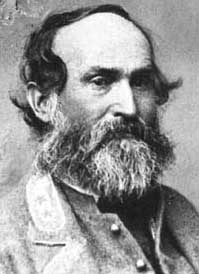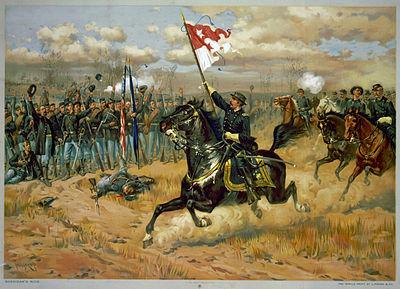 |
| Sheridan |
After defeating Early at the Battles of Opequon
and Fisher's Hill, Sheridan's Union army moved down the Shenandoah
Valley, leaving destruction in their wake. This was in line with the
Federal policy in other areas of the war – to break the Confederate
will to fight by destroying homes, crops and barns as they marched
through the countryside. Unlike Sherman in his march through Georgia,
Sheridan's men pillaged and burned under his orders. The valley was
sometimes called the Breadbasket of the Confederacy, and Sheridan was
determined that when he was finished, it would not be able to provide
any assistance to the Confederate cause. As one Union soldier wrote,
“The Valley is all ablaze in our rear.”
Early was not content to remain passive while
the Yankees wrought this work of destruction. Major General John
Gordon and staff officer Jedidiah Hotchkiss scouted a route that
would take the army along a narrow path on the northern slope of
Massanutten Mountain and across the Shenandoah River, so that they
could strike the left flank of the Union army, which was positioned
along Cedar Creek. The march went off without a hitch. Leaving on the
evening of October 18, the Confederates were in position to strike
early the next morning.
 |
| The Confederate attack |
At 5 am,
150 years ago today, the Rebels
charged toward the Union positions. The Federals were completely
surprised. Some units had not set out adequate pickets, and many
troops were caught unprepared in their camps. The
Army of West Virginia, the southernmost part of Sheridan's force, was
broken. Next up the line, Emory's XIX Corps, got in line to resist
the Confederate attack. They stood firm for some minutes, but they
were able to do little more than delay the Southern waves while other
units fell back. Soon they too were retreating, falling back north of
Middletown. They had, however, held long enough for Wright's VI Corps
to get in line. They too were driven back, though Getty's division
held a position in a cemetery for an hour. At that point the Federals
had established a main line to the north.
 |
| Early |
Early did not continue to press. His men were
hungry and tired after their all-night march and morning of fighting.
They believed the victory was already won, and they had the spoils to
prove it. They had captured 1,300 prisoners and 24 cannon. Sheridan
had actually been absent from the army when it was broken by this
Confederate attack. He was in Winchester, returning from a meeting in
Washington. When he heard the sounds of a major battle, he set out to
join the army, making what would become a famous ride on his horse,
Rienzi. When he reached his men he found them rallying, but
dispirited after their defeat. His arrival was just the inspiration
they needed. Although it is doubtful that if Sheridan had been on the
battlefield that morning he would have prevented the disaster, it
gave the Yankee soldiers a way to rationalize their reverse. Now that
Sheridan was on the field, they thought, their troubles would be
over. He rode along the lines, rallying and encouraging his men.
“Come on back, boys!” he shouted, “Give 'em h—l! … We'll
make coffee out of Cedar Creek tonight!”
 |
| Sheridan rallies the Union troops |
Sheridan
soon launched a counterattack. He placed the VI Corps on his left and
the XIX on his right, with the Army of West Virginia in reserve and
divisions of cavalry on both flanks. At
4 pm this line advanced, and drove
back Early's men toward Middletown. Soon the superior Federal numbers
drove the Confederates back. Some Confederates put up a good fight,
including Stephen Dodson Ramseur's division. He gathered a few
hundred men and resisted Sheridan's advance. Finally he fell mortally
wounded, with two horses shot from under him and balls through his
arm and both lungs.
 |
| The Union counterattack |
Under
Sheridan's orders, George Custer's cavalry division charged to try to
cut off the Confederate line of retreat to the river. He failed to do
so, but his charge inspired panic in the Confederate troops. In their
hurry to get away, a bridge collapsed on the small “No Name Creek.”
Unable to repair this in the face of the enemy, Early had to abandon
and captured guns or wagons north of the creek. The army was also
thrown into confusion as they hurried through the difficult
crossings.
 |
| Sheridan leads the charge |
The Federals lost 5,764 in this battle,
including 1,770 captured; the Confederates 2,910, with 1,050
captured. The Battle of Cedar Creek was a major blow to the
Confederate cause. Sheridan was free to continue up the valley,
burning and pillaging at will. The Confederates began by willing a
glorious victory, but the attacks were halted and the men turned to
plundering. They gave the Federals time to rally, and Sheridan's
counterattack turned the balance of the day. As Early told Hotchkiss,
“The Yankees got whipped and we got scared.”










0 comments:
Post a Comment